Guest Lecture Notes
advertisement
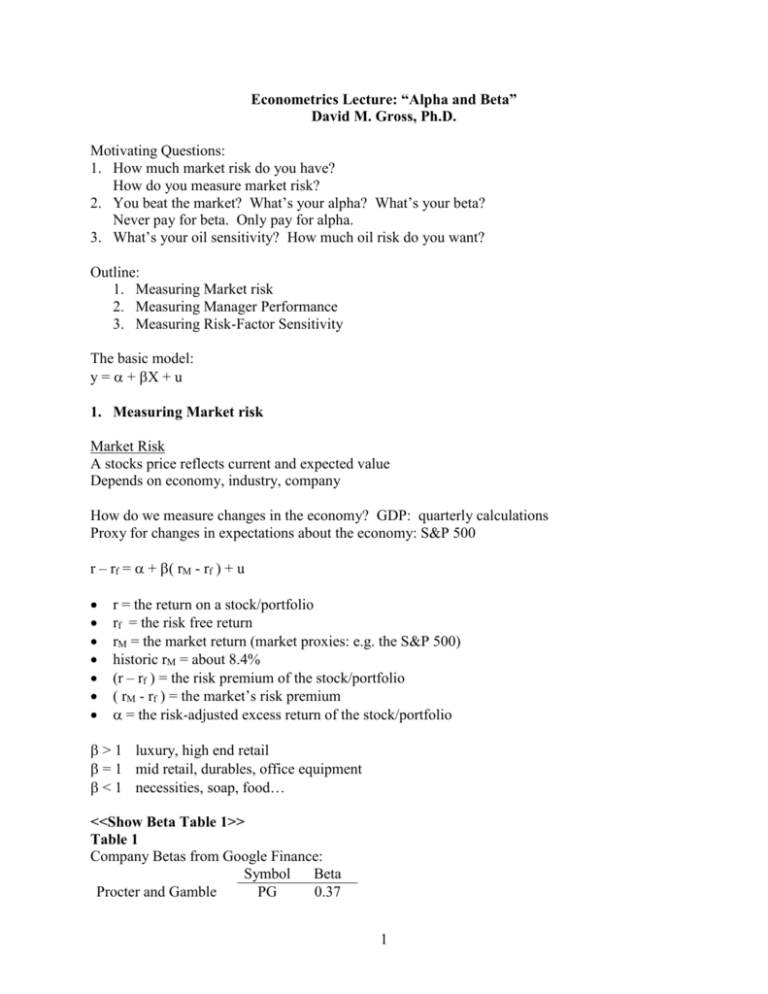
Econometrics Lecture: “Alpha and Beta” David M. Gross, Ph.D. Motivating Questions: 1. How much market risk do you have? How do you measure market risk? 2. You beat the market? What’s your alpha? What’s your beta? Never pay for beta. Only pay for alpha. 3. What’s your oil sensitivity? How much oil risk do you want? Outline: 1. Measuring Market risk 2. Measuring Manager Performance 3. Measuring Risk-Factor Sensitivity The basic model: y = + X + u 1. Measuring Market risk Market Risk A stocks price reflects current and expected value Depends on economy, industry, company How do we measure changes in the economy? GDP: quarterly calculations Proxy for changes in expectations about the economy: S&P 500 r – rf = + rM - rf + u r = the return on a stock/portfolio rf = the risk free return rM = the market return (market proxies: e.g. the S&P 500) historic rM = about 8.4% (r – rf ) = the risk premium of the stock/portfolio rM - rf = the market’s risk premium = the risk-adjusted excess return of the stock/portfolio > 1 luxury, high end retail = 1 mid retail, durables, office equipment < 1 necessities, soap, food… <<Show Beta Table 1>> Table 1 Company Betas from Google Finance: Symbol Beta Procter and Gamble PG 0.37 1 Altria Wal-Mart Office Max Target Apple AT&T Level 3 Qwest MO WMT OMX TGT AAPL T LVLT Q 0.42 0.50 1.05 1.20 1.32 1.54 2.27 2.50 Non-Market Risk 1 – R2 = SSR/SST Idiosyncratic risk, unique, Easily eliminated through diversification Those who diversify will require a lower return, pay more, so no compensation for diversifiable risk CAPM (Capital Asset Pricing Model) E(r) – rf = [E(rM) – rf] E(r) = rf + [E(rM) – rf] What if hold high beta stocks and the market is up? The CAPM says I should have a return that exceeds the market’s return. 2. Manager Performance You beat the market? Adjust for risk: Example: r =15%; = 2; rM = 10%; rf = 3% “Beat the market” since 15% > 10% Ex-post (CAPM is ex-ante): r – rf = (rM – rf) r = rf + (rM – rf) r = 0.03 + 2(0.10 – 0.03) = 0.03 + 2(0.07) = 0.03 + 0.14 = 0.17 15% < 17% So didn’t beat the market on a risk-adjusted basis r – rf = + rM - rf + u = r – rf – (rM – rf) = 0.15 – 0.03 – 2(0.10 – 0.03) = 0.15 – 0.03 – 0.014 = -0.02 = -0.02 = the risk-adjusted excess return <<Show Alpha and Beta Table 2>> Table 2 2 Estimated Betas and Alphas from 5 years of monthly data through 8/2007 Portfolio Return Beta Alpha S&P 500 9.98% 1.00 0.00 (0.00) (0.00) EVTMX 22.62% 0.73 0.15 (0.00) (0.00) FELBX 12.16% 2.16 -0.06 (0.00) (0.44) Hedge Fund 1 18.60% 0.79 0.10 (0.00) (0.02) Hedge Fund 2 20.02% 1.94 -0.07 (0.00) (0.05) 3. Risk Factors Define risk factors (energy, $, interest rates, …) 4. Use regressions to measure Factor Sensitivity 5. Use wine importer example to motivate $/Euro risk Model: (r – rf) = + rM – rf + F1 rF1 – rM + F2 rF2 – rM + … + u <<Show Oil Beta Table 3>> Table 3 Estimated Betas from 5 years of monthly data through 8/2007 Which firm is the airline? Which is the oil company? Beta Market Beta Oil Firm A 0.99 0.35 (0.00) (0.00) Firm B 1.78 -0.54 (0.00) (0.03) Which one is the airline? Which is the oil company? Multi-factor alpha: = the multi-factor risk-adjusted excess return Used by Morningstar (Describe Morningstar) 3






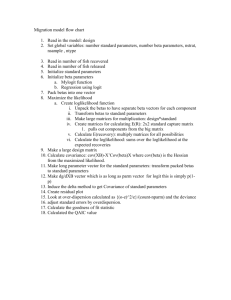
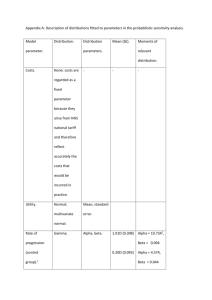
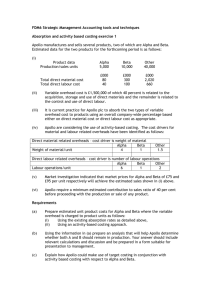
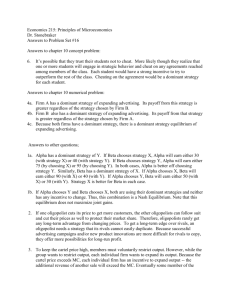
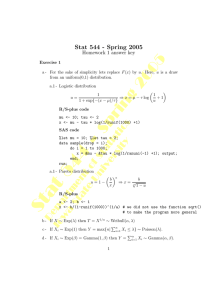
![Cost of Capital - of [www.mdavis.cox.smu.edu]](http://s3.studylib.net/store/data/008952041_1-d815507e779b91930bdfd4a584f3c02a-300x300.png)